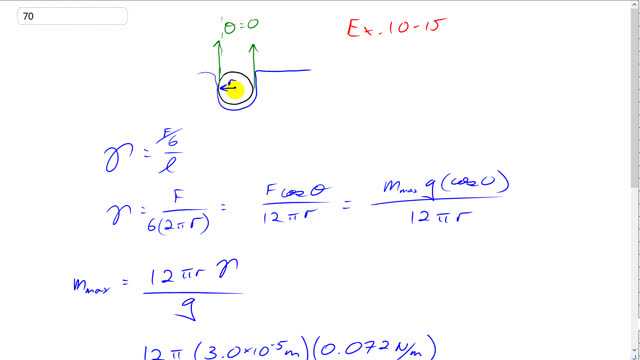
If the base of an insect’s leg has a radius of about and the insect’s mass is 0.016 g, would you expect the six-legged insect to remain on top of the water? Why or why not?

In order to watch this solution you need to have a subscription.
This is Giancoli Answers with Mr. Dychko. Using the model from example 10-15, we have an insect leg here in the water making a bit of a depression here. Insect leg has a radius r and the surface tension is going straight up here this is the point where you have the maximum surface tension when it's when the leg is sunken down so much that a force tangent to the surface which is the direction the surface tension acts it acts tangent to the surface or along the surface when it happens to be going straight up and you have Θ equaling zero this is where you have the maximum surface tension force in the upwards direction. So and this surface tension gamma is force divided by length over which the surface tension force is acting Since the insect has six legs, each force is gonna be F over 6 or one-sixth of the total force needed to support the insect and the length over which the force is acting is the circumference of this leg. I mean if you were to look at this top-down view, you have this force acting out of the page all along— drawing a little arrowheads here to show force arrows coming out of the page— all along the perimeter of this insect leg. So l is 2πr and we have this 6 in the denominator now. So the force is F times cos Θ this being the component of the surface tension force it's vertical but since Θ is zero, cos of 0 is 1 and so cos is gonna just disappear and so the maximum force is gonna be the maximum mass the insect could have times g and that's divided by 12πr. So we'll solve for this maximum mass and then compare it to the mass that we are given in the question and we have maximum mass is 12πr times γ over g. And so that's 12π times 3.0 times 10 to the minus 5 meters times 0.072 newtons per meter— surface tension of water at 20 degrees Celsius divided by 9.8 newtons per kilogram that gives 8.3 times 10 to the minus 6 kilograms is the maximum mass the insect could have and their actual mass is 0.016 grams and that's much greater than 0.0083 grams which is what this works out to if you convert it into grams and therefore the insect will sink since their mass exceeds the maximum.